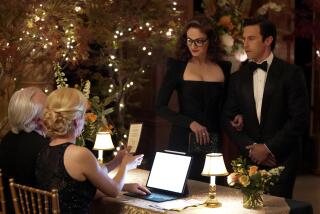Star Quotient
- Share via
Every week on the CBS crime series “Numb3rs,” another chalkboard-filling calculation helps find a serial killer, solve a kidnapping or thwart larceny. On the show, the numbers are crunched by Charlie Eppes, a math professor at fictional CalSci played by heartthrob David Krumholtz. In real life, CalSci is a close facsimile of Pasadena’s own Caltech and the computational heavy lifting is being done by the show’s math consultant, Professor Gary Lorden, the head of Caltech’s math department. We quizzed the professor about what it’s like bringing his passion for statistics and probabilities to the masses. And yes, there’s going to be math.
OK, how many decimals of pi can you give me?
A few years ago, I memorized it to 15 or 20 places, I think 3.1415926. I’m not as sure of the last two digits. I know some mathematicians who have memorized a couple thousand digits of pi just for fun.
In real life, how applicable is mathematics to actual crime-solving?
It’s not only solving crimes. It’s looking for terrorists. It’s trying to make cryptography work in both directions, have your messages not [be] stolen by somebody else and stealing somebody else’s messages. The National Security Agency hires more PhD mathematicians than any university or Microsoft or any of those other companies.
But would your average gumshoe be using number theory?
A lot of crime is corporate, white-collar crime that involves huge databases. I’m consulting now for a firm whose service is to look at millions of documents in some sort of corporate fraud case and find the ones that need to be delivered to the other side, or that need to be looked at by prosecutors. And that would be true in crime investigation.
What formula do you think of as having star quality?
If I wanted to do a hit list, Kim Rossmo’s formula for defining the hot zone in a serial attacker. That’s applied math. At the other end of the spectrum, my colleague Dinakar Ramakrishnan put down some formulas characteristic of what’s called the Riemann Hypothesis, formulas defining the Riemann zeta function, and Euler’s Product. Those formulas are some of the most beautiful things in number theory.
What makes a formula “elegant,” a word that often is used on the show?
“Elegance” is one of our special words, like “trivial” or “obvious.” We mean the reasoning, the process of getting from A to B to C, finally to X. An elegant proof conveys what’s going on in a poetic [way]. It’s sort of what Keats said: “Beauty is truth, truth beauty.” Some equations and algorithms [are] elegant because they’ve condensed in a beautiful way what’s essentially going on. It’s one of the highest compliments that you can pay.
Is there anything about the mathematician hero on “Numb3rs” that is not true to math life?
Well, he’s not drinking coffee or Coke, and I can hardly think of a mathematician who doesn’t, especially at night. The other thing is very few mathematicians listen to music while they’re working, and [the show’s writers] really like the idea. So Charlie does put on headphones and listen to music.
Has enrollment gone up in the wake of “Numb3rs”?
Caltech last spring did have a good year for applications, and I think a lot of people know that CalSci is really just a close approximation of Caltech. As a statistician, I was impressed that in this year’s freshman class of 235 at Caltech, there were 36 students who said they were going to be math majors, which is about twice as many as we’ve had before. Maybe there is a trend.
How well have the producers re-created the Caltech math department?
They’ve done something really clever, which is to make an oil painting of me that looks just like the oil painting of Alfred P. Sloan, who gave the money for the math building at Caltech. It appears on their math department set in downtown Los Angeles as the donor’s oil painting.
The “Numb3rs” whizzes are sexy and glamorous. Doesn’t this fly in the face of the geeky mathematician stereotype?
I’ve got to tell you there are some extremely good-looking people in the Caltech math department. It’s not that unrealistic.
More to Read
The complete guide to home viewing
Get Screen Gab for everything about the TV shows and streaming movies everyone’s talking about.
You may occasionally receive promotional content from the Los Angeles Times.




